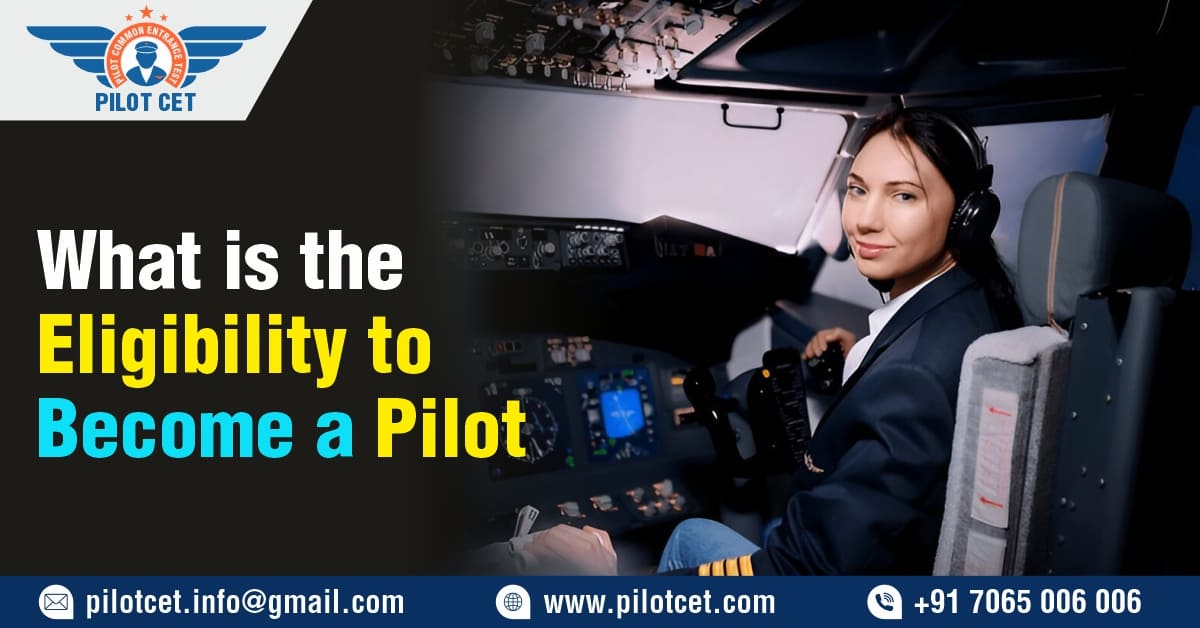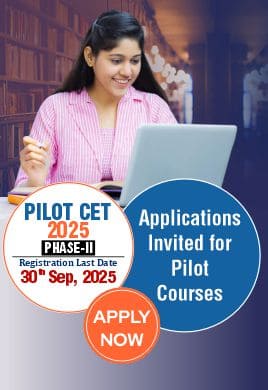
What is the eligibility to become a pilot?
Before you starting journey "What is the eligibility to become a pilot?" is the most asked question amongst aspiring pilot candidates. Pilot student should know the complete eligibility criteria for pilot training in India before joining for the course. These requirements cover age, education, medical fitness and the number of flying hours which differ based on the license. Choosing the right license will depend on your career goals for example SPL (Student Pilot License) for beginners, PPL (Private Pilot License) for hobby flying, CPL (Commercial Pilot License) for commercial flying and ATPL (Airline Transport Pilot License) for airline captains.
Knowing the exact eligibility criteria to become a pilot is very important toward the future your aviation career. Once you meet the basic pilot training eligibility then you can move ahead with confidence and plan for your dream profession. Understanding these requirements early helps you save time, money and effort during your pilot journey.
Educational Qualification
Educational qualification for different licenses which is almost same for every licence except SPL & PPL. Details are given below:
- SPL (Aeroplane & Helicopter):
Must have passed Class 10th from a recognized board.
- PPL (Aeroplane & Helicopter):
Must have passed Class 10th from a recognized board.
- CPL (Aeroplane & Helicopter)
10+2 with Physics, Chemistry & Mathematics (PCM) with a recognized board or equivalent polytechnic diploma.
- ATPL (Aeroplane & Helicopter)
10+2 with Physics, Chemistry & Mathematics (PCM) with a recognized board or equivalent polytechnic diploma.
Age Criteria
Below is given the age criteria for every license:
- For SPL (A/H): you must be at least 16 years old. ·
- For PPL (A/H): the minimum age is 17 years.
- For CPL (A/H): you need to be 18 years or older.
- For ATPL (A/H): It is the highest qualification, you must be at least 21 years old.
Medical Fitness
SPL (A/H) & PPL (A/H):
You must have a DGCA-approved Class 2 Medical Certificate. This covers basic health checks like eyesight, blood pressure, hearing and overall physical condition to ensure you are fit to operate an aircraft at a non-commercial level.
CPL (A/H) & ATPL (A/H):
You must have a DGCA-approved Class 1 Medical Certificate. This is more comprehensive and includes advanced tests such as ECG, lung function, blood tests, and detailed eye and hearing exams to confirm your ability to handle the high demands of professional and airline flying.
DGCA-Modules
Students first have to study the 6 DGCA modules of pilot training. After qualifying these modules student can further pursue flying training. Below is given all 6 modules related to pilot training:
|
Module |
Description |
|
Air Regulations |
Rules, laws, and procedures governing civil aviation. |
|
Aviation Meteorology |
Weather systems, forecasts and their effects on flying. |
|
3. Aviation Regulations |
DGCA rules, licensing regulations and operational procedures. |
|
4. Technical - General |
Basics of aircraft/helicopter components, engines and systems. |
|
5. Technical - Specific |
Detailed knowledge of aircraft/helicopter type, performance and limitations. |
|
6. RTR |
Procedures and protocols for communicating with ATC. |
Flying Hours
There is specific flying hours required to complete to get the license you want. This is the crucial part of the training as it provides the real life experience to fly an aircraft safely. Below is given the complete details of flying hours required for each license:
SPL (Student Pilot License)
|
Details |
SPL (A) - Aeroplane |
SPL (H) - Helicopter |
|
Total Flying Hours |
No minimum required |
No minimum required |
|
Requirement |
Basic ground training + medical clearance |
Basic ground training + medical clearance |
PPL (Private Pilot License)
|
Details |
PPL (A) - Aeroplane |
PPL (H) - Helicopter |
|
Total Flying Hours |
40 hours |
40 hours |
|
Solo Flying |
20 hours |
15 hours |
|
Dual Flying |
10 hours |
10 hours |
CPL (Commercial Pilot License)
|
Details |
CPL (A) - Aeroplane |
CHPL - Helicopter |
|
Total Flying Hours |
200 hours |
150 hours |
|
Pilot-in-Command (PIC) |
100 hours |
50 hours |
|
Cross-Country Flying |
20 hours |
20 hours |
|
Instrument Flying |
10 hours |
10 hours |
ATPL (Airline Transport Pilot License)
|
Details |
ATPL (A) - Aeroplane |
ATPL (H) - Helicopter |
|
Total Flying Hours |
1500 hours |
1000 hours |
|
Cross-Country |
500 hours |
350 hours |
|
Night Flying |
100 hours |
100 hours |
|
Pilot-in-Command (PIC) |
250 hours |
200 hours |
Nationality Requirements
Indian citizens and NRIs are eligible to pursue pilot training in India. Some requirements are there to fulfill like VISA, passport or background verifications etc.
|
Requirement |
Details |
|
Eligible Candidates |
Indian citizens or NRIs |
|
Passport |
Mandatory for international licenses and foreign airline employment |
|
Background Verification |
Required for both domestic and international licenses to meet security standards |
Skills Requirement
- Communication & Decision-Making: Clear communication and quick decision making is necessary as pilot have to communicate with the ATC and handle the emergency situations.
- Technical Knowledge: He should have great understanding of aircraft systems and navigation etc.
- Situational Awareness: Staying focused and monitoring environment and aircraft status to prevent any emergencies.
- Leadership & Teamwork: Pilots leads the crew and working staff so it is essential for him to maintain the teamwork so the journey will complete smoothly.
- Emotional Stability: Staying calm under pressure is important in any situation.
- Problem-Solving: Pilot must be good at solving problems & handling emergencies efficiently.
- Time Management: Managing flights and schedules efficiently.
Entrance Exam & Scholarships
Aspiring students can give entrance exam like Pilot CET or AME CET to get admission in top DGCA approved flying schools and avail scholarships to reduce their financial burden. And can make their career in commercial pilot, airline captain charter pilot and many more. Below is given step by step guide to from giving the exam to getting the admission:
Step 1: Submission of Application Form
- Visit the official Pilot CET website at https://pilotcet.com.
- Fill out the application form accurately with all the required details.
Step 2: The Entrance Exam
- Appear for the Pilot CET exam, which tests your knowledge in Physics, Mathematics, English & reasoning ability.
Step 3: Counseling and Seat Allotment
- After the results are announced, qualified students will be invited for counseling sessions.
- During counseling students can choose their preferred pilot training institute and course (SPL, PPL, CPL or ATPL) based on their AIR rank and seat availability.
Step 4: Admission & Fee Payment
- Once your seat is allotted, proceed with document verification and pay the required admission fee to confirm your enrollment in the chosen pilot training program.
After meeting the above giving eligibilities aspiring students can begin their global journey toward becoming a licensed pilot and fly with airlines worldwide. For more info put a query on Pilot CET website.
Frequently Asked Questions
To become a pilot in India you need to complete Class 12th with Physics and Mathematics. You must also pass a medical examination and meet the required age criteria.
read more..
Commercial Pilot License Commercial Helicopter Pilot License Private Pilot License Private Helicopter Pilot License

